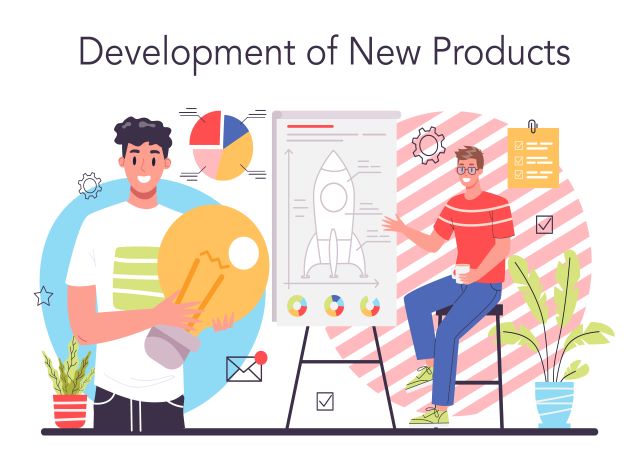Product development can be an exciting but tiring process. Various steps are involved in the product development process right from idea generation to market launch. But what exactly is product development?
A product development company refers to it as a process of building an in-demand product from scratch to making it available for the market. The product development process involves various steps such as ideation, market research, product research, prototyping, design and production, marketing, etc.
The product development process is broken down into several small steps to organize the process and keep it structured. For the product to be in demand with the market requirements, creativity is mixed with strategy. Product development has to go through different stages of iteration and testing to create an effective product that best suits the market.
Different stages of product development
A product is just an idea at the very beginning. An idea that goes through multiple rounds of brainstorming sessions before coming into its final stage. The product development process has different stages, which are mentioned below:
Ideation:
Ideation is the first step in a well-developed product development strategy. This step involves brainstorming and forming a rough picture of the product. The brainstorming sessions will involve a lot of factors. The different steps will involve evaluating the target market and your potential customers to get an idea of what you will be creating. It will help you identify the gap between the existing product and the needs of the customers.
The ideation stage will also involve analyzing the existing market products. What if you are on your way to creating a similar product that exists out there in the market? All your hard work will go down the drain. To avoid that, you need to have an idea of the existing products in the market. Similarly, checking the functionality of your product and deciding how it will work, its features, etc., will also matter a lot.
Defining your product
After the ideation stage, and considering other factors such as target market and functionality, you can move on to product definition. Product definition will include various steps such as building a product roadmap, competitor analysis, etc.
The product-defining stage will also include the value proposition. The value proposition is essential to identify what pain point you are trying to solve with your product. The value proposition is essential for identifying market trends and creating a watertight marketing strategy.
Further ahead, you will also have to identify how you will define your product’s success once it is in the market. Success metrics can include key performance indicators and other quantifiable data points. Lastly, prepare a rock-solid marketing strategy for your product. Define which medium you wish to use for marketing, and plan accordingly!
Prototyping
Prototyping is a crucial step in the product development stage. While you are working on a product design, there might be a lot of potential risks that can go unnoticed. After preparing a strategy for your product, it will be essential to check its feasibility and identify potential risks customers pose.
Once you have identified the potential market risks and feasibility, you can start with the development strategy. It will also help you fix a tentative timeline for various steps involved in the product development process.
Moreover, the prototyping stage will also involve building a Minimum Viable Product (MVP). An MVP is useful to test the functionality of your product and collect feedback accordingly. Moreover, an MVP will also be helpful to launch desired features in the product.
Product testing
Once you are done with the first three steps, you’ll have to engage in product testing. This step is of immense importance, and product development services providers make sure to include it in their pipeline. Product testing and validation are necessary to ensure the seamless working of your product before launch.
Assessment will involve market testing and checking whether your product is to meet the customer’s needs and fill the gap. You will also have to check your product on the front-end side and ensure seamless functionality. Product testing will also involve collecting feedback from the concerned stakeholders.
Product testing will ensure that the final product meets the expectation of all the key stakeholders. Hiring a product development specialist would be a better option to get the desired result.
Product launch
After completing and going through every stage, your product is ready to enter the market. Commercialization is the last step of the product development process. After passing every stage, you can launch your product and also start your marketing campaign. You will have the final design with you and all the essential metrics to define the success of your product. Your team will have to make sure that it is ready to go out for e-commerce implementation.
The product development process requires hours of hard work and brainstorming sessions to build the product from scratch and make it ready for the market. An unstructured product development strategy can hamper your product’s performance. You need to understand the demand to create the proper supply. Market research and understanding the customer’s needs as well as requirements will not only help you streamline the process but develop a product that fits the market.

As the editor of the blog, She curate insightful content that sparks curiosity and fosters learning. With a passion for storytelling and a keen eye for detail, she strive to bring diverse perspectives and engaging narratives to readers, ensuring every piece informs, inspires, and enriches.










